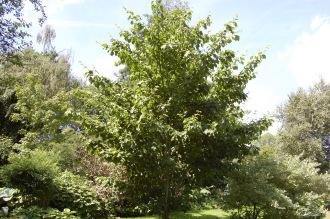
Acer rufinerve (18/07/2015, Kew Gardens, London)
Position: Full sun to light shade
Flowering period: Late spring
Soil: Moist, well drained
Eventual Height: 12m
Eventual Spread: 9m
Hardiness: 6b, 7a, 7b, 8a, 8b, 9a
Family: Sapindaceae
Acer rufinerve is a deciduous tree with a rounded habit. Its dark green leaves are broadly ovate with serrulate margins, three lobed, up to 16cm long and 16cm broad. Its leaves turn orange to red in autumn before they fall. Its trunk may achieve a diameter of 40cm. Its light gray and olive green striped bark is smooth. Its yellow flowers are small, produced in racemes and up to 10cm long. Its green fruit is a samara which is up to 3cm long.
Acer rufinerve, commonly known as the Redvein Maple, Snake Bark Maple or Grey Snake Bark Maple, is native to Japan. In its native habitat it grows in mountain forests. There is currently discussion that this tree may be invasive in parts of Northern Europe.

Acer rufinerve Leaf (18/07/2015, Kew Gardens, London)
The etymology of the binomial name Acer is derived from the classical Latin name for the Maple. Rufinerve is derived from the Latin rufus menaing ‘red’ and nervus meaning ‘veined’.
The landscape architect may find Acer rufinerve useful as a small tree with attractive bark and autumn leaf color.
Ecologically, Acer rufinerve is attractive to pollinating insects.
Acer rufinerve prefers moist, fertile, well-drained soils. It tolerates most pH of soil.
Acer rufinerve requires little maintenance. Pruning should be carried out during the dormant months.

Landscape Architecture

